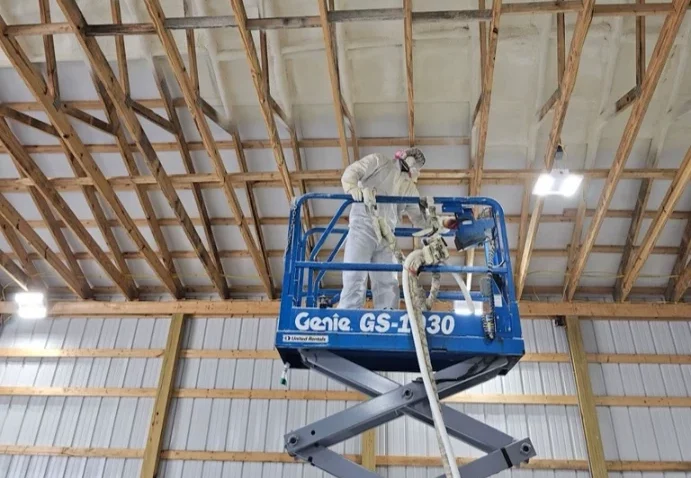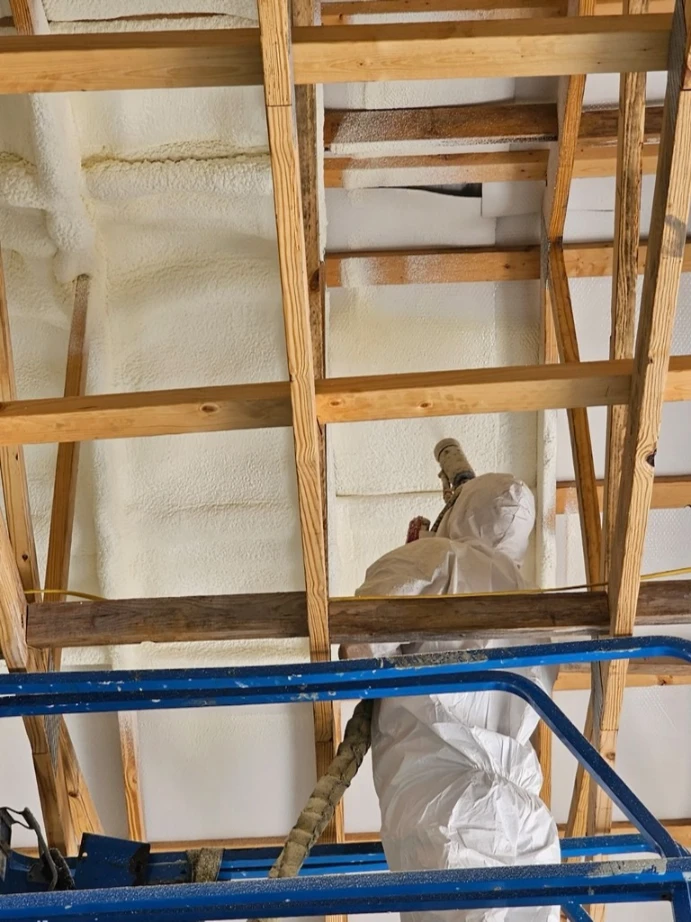
Spray foam insulation creates a continuous air seal that reduces heat transfer, minimizes drafts, and limits energy loss through walls, roofs, and crawl spaces. This barrier prevents conditioned air from escaping and blocks outdoor temperatures from entering, resulting in significantly lower HVAC usage and consistent indoor comfort.
The insulation’s high R-value per inch and ability to expand into small gaps make it more effective than traditional insulation types in reducing year-round heating and cooling costs. According to the U.S. Department of Energy, heating and cooling account for 49% of energy use in an average home (source: energy.gov), making insulation upgrades one of the most impactful improvements for energy savings.
Armored Insulation applies spray foam across a wide range of building types and climates, particularly where seasonal extremes or poor building envelope conditions demand durable insulation solutions.
| Feature | Spray Foam Insulation | Blown-In Insulation | Fiberglass Batt | Mineral Wool |
|---|---|---|---|---|
| Air Sealing | High (Expands to seal gaps) | Moderate | Low | Moderate |
| R-Value per Inch | 6.0–7.0 (Closed Cell) | 2.2–3.8 | 2.9–3.8 | 3.0–4.0 |
| Moisture Resistance | High (Closed Cell) | Low | Low | High |
| Mold Resistance | Excellent | Low | Low | High |
| Durability | 20+ Years | 10–15 Years | 10–15 Years | 20+ Years |
| Performance in Humid Regions | Excellent | Low | Low | Good |
Bonus Tip: Closed cell spray foam adds structural reinforcement, which helps in areas with high wind load or seismic activity.
Spray foam forms a monolithic insulation layer, reducing heat movement through conduction, convection, and air leakage. It directly affects energy usage in both heating and cooling seasons:
The Oak Ridge National Laboratory found that spray foam can reduce HVAC energy consumption by up to 40% when properly installed (source: ORNL.gov).
| Metric | Closed Cell Spray Foam | Open Cell Spray Foam |
|---|---|---|
| R-Value (per inch) | 6.0–7.0 | 3.5–3.7 |
| Air Leakage Reduction | Up to 90% | Up to 80% |
| Vapor Permeability | Low | High |
| Water Absorption | <1% | 5–10% |
| Best Application Zones | Roofs, Crawl Spaces, Exterior Walls | Interior Walls, Ceilings |
Bonus Tip: In regions with high humidity, closed cell foam is preferred for crawl spaces and attics to reduce mold growth and water vapor penetration.
Kentucky’s climate ranges from humid summers to cold winters. These seasonal shifts make insulation performance critical. Spray foam offers:
Blown-in or batt insulation often struggles with moisture retention, leading to sagging or compression, reducing long-term performance.
Before selecting spray foam insulation, consider the following:
Bonus Tip: For retrofits, infrared thermal imaging before and after installation can help verify performance improvement.

Use an energy audit or blower door test to identify key leakage points before choosing insulation areas.
Yes, in many cases. It can act as an additional air seal over other materials when conditions allow.
Avoid applying over wet surfaces or certain untreated metal panels prone to corrosion.
Yes, typically for 24 hours due to off-gassing during curing. Confirm safety protocol with the installer.
Spray foam insulation delivers measurable energy savings and improved building performance when used in the right context. Evaluate your home’s specific needs and compare insulation materials by performance and durability. Long-term efficiency gains often outweigh initial complexity or access considerations.
For expert installation backed by years of hands-on experience across Kentucky homes and buildings, contact Armored Insulation at (270) 331-4844 or [email protected]. Our team assesses each structure individually to deliver consistent results aligned with building performance standards.
Properly applied spray foam lasts over 20 years without significant degradation.
No ongoing maintenance is required. Periodic inspections can help identify damage from external causes.
Spray foam deters most pests, though rodents can burrow if access points are not sealed.
It is not fireproof but can be treated with fire-retardant coatings per building code.
Open cell foam provides good sound dampening in interior walls.